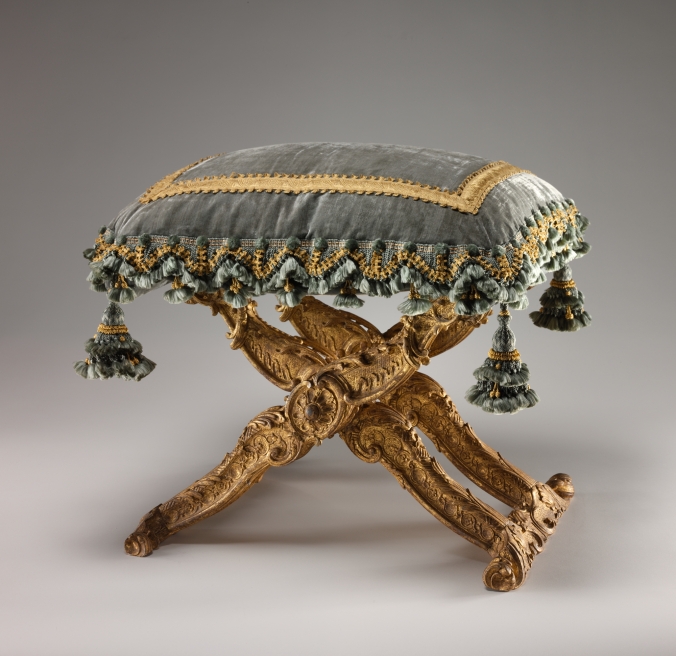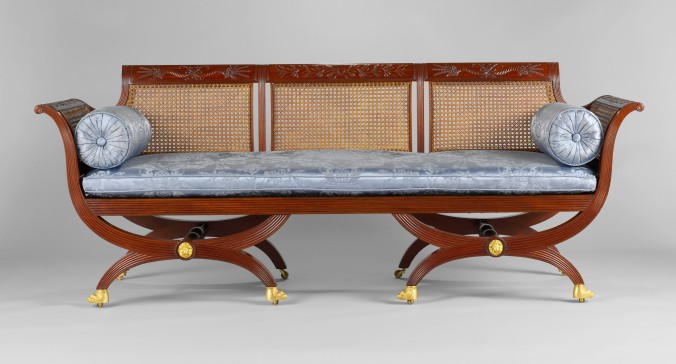You may not be familiar with the term curule, but you will no doubt be familiar with the furniture made in the curule form. The history behind this furniture is fascinating, and the way that the furniture has evolved throughout time provides an interesting timeline that is still evolving.
Curule is defined as a something relating to the authority of the senior magistrates in ancient Rome who, because of their status, were entitled to sit in the sella curulis. This curule seat is a type of chair that is in the form of an x and therefore can be folded. Over the years, these seats have been called everything from a Dante chair, a Savonarola chair, a scissors chair, or more simply, a cross-frame chair.

A French Louis XV giltwood x-frame stool,
Metropolitan Museum of Art
The revival of interest in antiquity in the 18th century saw the resurgence of the popularity of curule seats. The above photograph shows a giltwood stool made for the French Royal court in the 1730s, and this particular one features an inventory mark of the palace of Versailles.
The interest in curule seats continued in the Regency period in the early 19th century. These elegant cross-frame stools shown above reflect the work of the pre-eminent designer Thomas Hope. Hope was greatly influenced by his extensive Grand Tour travels across Europe as well as Greece, Turkey, and Egypt. When he returned to London, he set out to make his Duchess Street home a showcase of antiquity across the different cultures, including Egyptian, Greek, Roman, and Indian elements.
Hope officially opened his home in 1802 to visitors, and the Prince of Wales made an appearance at the grand opening. Duchess Street became an attraction for the discerning connoisseur and many notable figures travelled to see Hope’s interiors, including the artist Benjamin West, who proclaimed that it was ‘the finest specimen of true taste… either in England or in France.’ The stools in our collection reflect the interest in the revival of Roman traditions and taste as reflected in the overall form and animal motifs.

A mahogany sofa attributed to Duncan Phyfe in the curule form
Metropolitan Museum of Art
The interest in the curule form was not restricted to Europe. A large suite of seat furniture attributed to the American designer Duncan Phyfe once owned by Thomas Cornell Pearsall, a wealthy New York merchant, feature the curule form in a pared down design. Phyfe would have drawn the design from the 1808 supplement to the London’s ‘Chairmakers’ and Carvers’ Book of Prices.’
The curule form was used throughout the 19th century to appeal to antiquarian taste. This pair of walnut curule-form armchairs, upholstered in green silk velvet, were once owned by the renowned English furniture collection, Irwin Untermyer.

A Curule by Pierre Paulin
Offered by Ligne Roset
And of course, the curule form lives on today in contemporary design. Shown above is a curule by Pierre Paulin, designed in the 1980s, offered by Ligne Roset.
So next time you see a curule form stool, chair, or sofa, think of the Roman magistrates that inspired the design–and enjoy the beautiful simplicity of the form.





At Versailles there were strict rules governing who were allowed to sit on such stools.
LikeLike
What a fascinating way to create a hierarchy!
LikeLiked by 1 person
Pingback: Make a Good First Impression: Georgian Hall Chairs | The Source